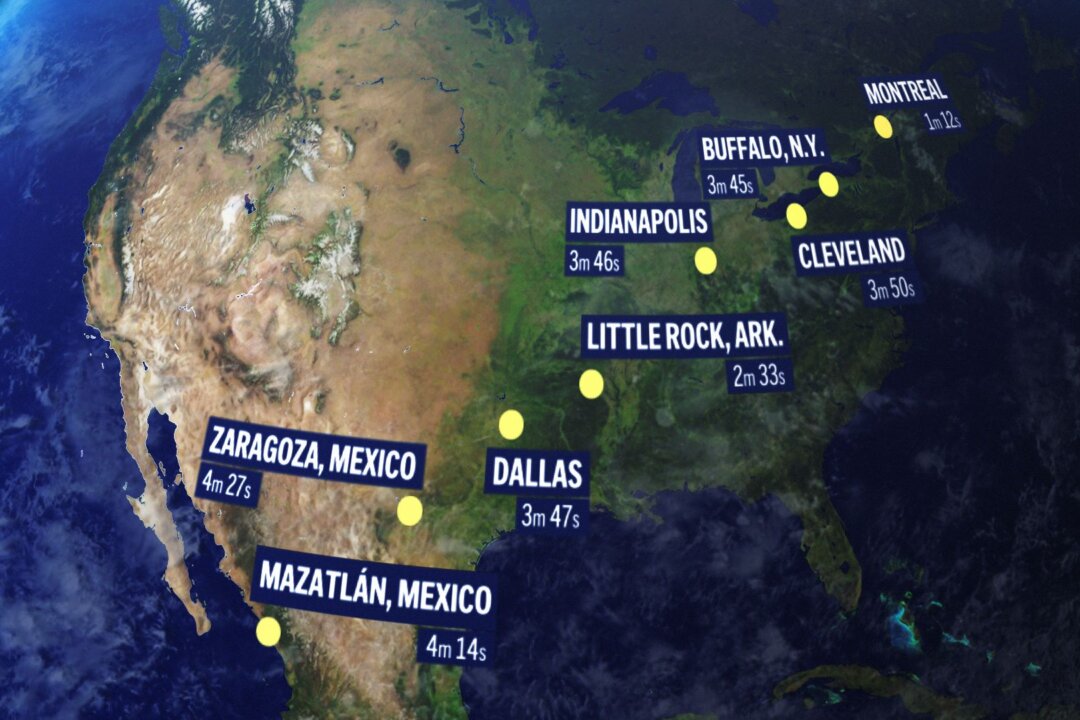On April 8, 2024, a total solar eclipse will cross North America, passing over Mexico, United States, and Canada. Only 21 total solar eclipses have crossed the lower 48 states during the existence of the United States of America.
A total solar eclipse happens when the Moon passes between the Sun and Earth, completely blocking the face of the Sun. The sky will darken as if it were dawn or dusk.
Residents in 15 states—Texas, Oklahoma, Arkansas, Missouri, Tennessee, Illinois, Kentucky, Indiana, Ohio, Michigan, Pennsylvania, New York, Vermont, New Hampshire, and Maine—will have the opportunity to witness the moon completely blocking the sun’s view in 2024.
Safety is the number one priority when viewing a total solar eclipse. Be sure you’re familiar with when you need to wear specialized eye protection designed for solar viewing by reviewing these safety guidelines from NASA.
Except during the brief total phase of a total solar eclipse, when the Moon completely blocks the Sun’s bright face, it is not safe to look directly at the Sun without specialized eye protection for solar viewing.
Viewing any part of the bright Sun through a camera lens, binoculars, or a telescope without a special-purpose solar filter secured over the front of the optics will instantly cause severe eye injury.
When watching the partial phases of the solar eclipse directly with your eyes, which happens before and after totality, you must look through safe solar viewing glasses (“eclipse glasses”) or a safe handheld solar viewer at all times. You can also use an indirect viewing method, such as a pinhole projector.
Overkill?
So I’m directly in the path of the eclipse and thought, “Wow… that’s cool.” And then I read that our @wef gov @GovHolcomb has already declared a state of emergency. For 7.5 minutes of darkness the equivalent of dawn or dusk? Seriously, what am I missing? #SolarEclipse pic.twitter.com/FutUYpcqkn
— Douglas Karr (@douglaskarr) April 4, 2024
Many states are declaring a state of emergency in mere anticipation of the event. Most of the concerns focus on highways turning into parking lots. During the 2017 eclipse, gas stations ran out of fuel as out of towners refilled and tankers couldn’t get in to refill.
Will there be traffic problems Monday before and after the eclipse? Probably.
The Denver Post reported more than half a million cars in a record-breaking Wyoming traffic jam during the 2017 solar eclipse.
What should have been “a four-hour drive from Denver into a frustrating, 10- or 12-hour marathon,” the paper reported.
“Crickets chirped, temperatures dropped, and an eerie calm spread across the landscape as the sunny sky dissolved into hues of purple and glorious blue. Moments later, the sun peeked out again, and Wyoming’s roadways suddenly resembled the road to Reno after Burning Man, or the packed freeway lanes in Los Angeles during rush hour.”
Another issue is overloading cellphone towers and weakening signals.
Could it be a bust?
As anticipation builds for Monday's total solar eclipse, clouds and rain could obscure views in the South with the potential for severe weather along the path of totality.@JacquiJerasTV has a look at the forecast. #SolarEclipse2024 pic.twitter.com/TPFi9nVFVd
— The Weather Channel (@weatherchannel) April 4, 2024

